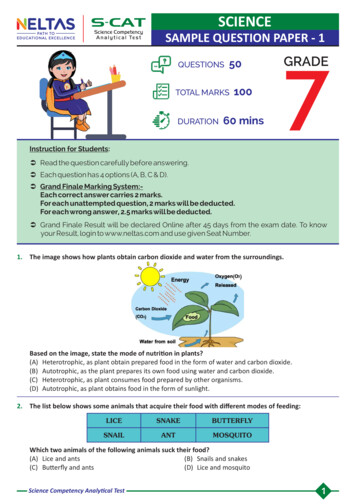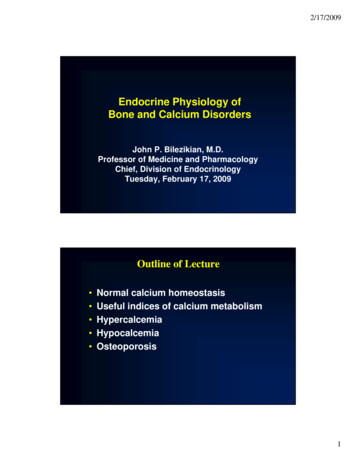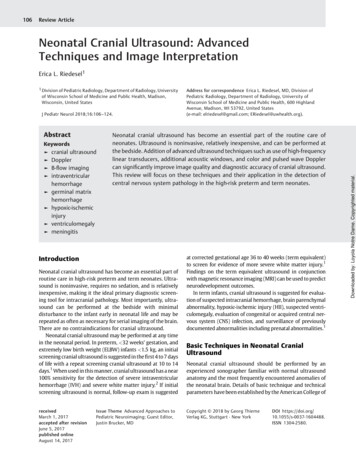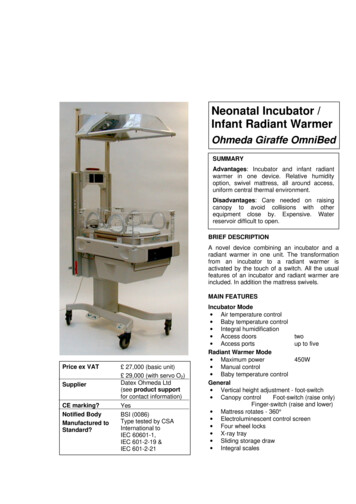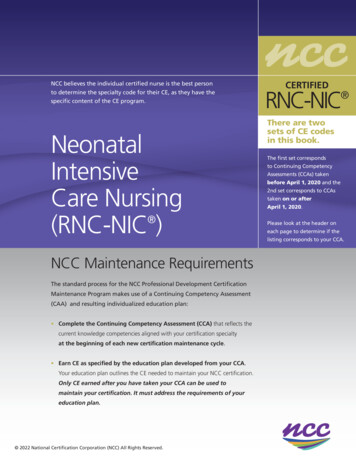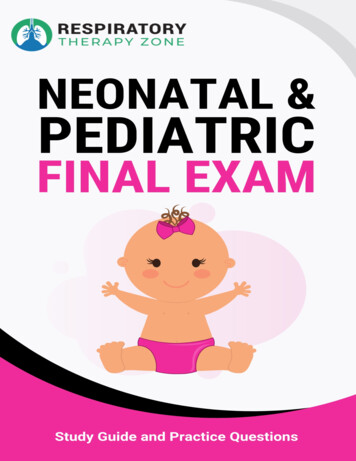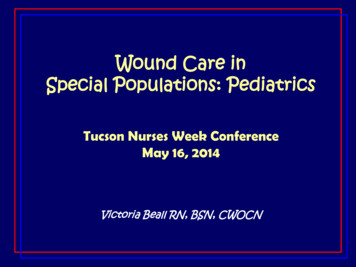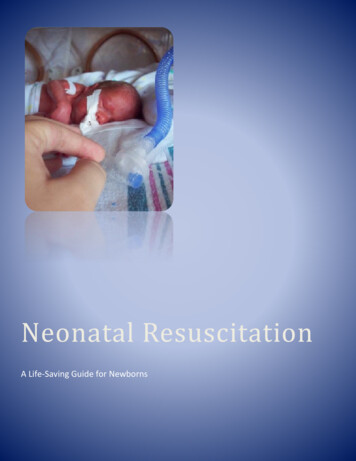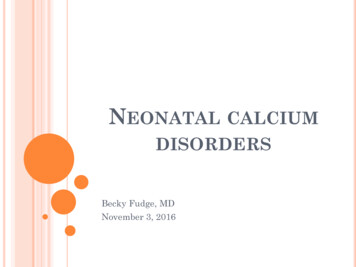
Transcription
NEONATAL CALCIUMDISORDERSBecky Fudge, MDNovember 3, 2016
NEONATAL CALCIUM DISORDERS: OBJECTIVES Review physiology of calcium regulation Discuss causes and management of neonatalhypocalcemia Define causes of hypercalcemia and discussmanagement strategies
INTRODUCTION Adequate extracellular calcium concentrationneeded to sustain normal physiological processes Bone formation & turnoverMuscle contractilityNeuron excitabilityBlood clottingCellular metabolismExtracellular calcium levels set in narrow range byregulatory “calciotropic” hormones
CALCIUM PHYSIOLOGY Calcium is one of most abundant minerals inbody 98% mineral salts in bone reservoir 2% soluble formBone remodeling Intestinal absorption Renal reabsorption Calcium forms in serum 30-50%: Protein bound (albumin)5-15%: complex with anions (phosphate)40-50%: ionized, metabolically active
HORMONAL REGULATION OF SERUM CANet effect:PTH: Ca PhosVitamin D: Ca Phos
PTH EFFECTS Action mediated through PTH1R onosteoblasts and kidneyOsteoblasts: Stimulates IL-6 secretion which promotesosteoclast differentiation Stimulate production of RANKL andinhibit Osteoprotegerin (OPG) Promotes calcium mobilizationRenal tubule Activation of 1-α-hydroxylase Increases calcium resorption PhosphaturiaGI tract: Indirectly increases Ca and Phosabsorption via calcitriol
CALCIUM SENSING RECEPTOR Transmembrane G-protein coupledreceptor expressed in chief cells, renaltubule, bone, brain and GI tractExtremely sensitive to small percentchanges in ionized Ca concentration Affinity determines Ca setpoint Activation of CaSR inhibits PTH secretion Activation of CaSR in renal tubule inhibitscalcium reabsorption
EFFECTS OF CASR MUTATIONS ON PTH-CA CURVEAutosomal dominanthypocalcemiaHypocalciuric hypercalcemia
VITAMIN D Effects mediated through VDR Nuclear receptor which interacts withretinoic acid X receptor Binds to vitamin D response elementsKidney Potentiates action of PTH in increasingcalcium absorption Feedback inhibition of 1α-hydroxylase &activates 24-hydroxylationBone Stimulates osteoblast production offactors promoting osteoclast activity Role in coordinating bone remodelingunits through regulation of RANKL/OPGIntestine Major determinant of calciumreabsorptionParathyroid Feedback inhibition of PTH release
PHYSIOLOGY IS FUN!!!
FETAL CALCIUM METABOLISM Development of fetal skeleton is dependent onsufficient maternal supply of calciumActive transfer of calcium from mother to fetus Fetal/maternal total calcium concentration: 1.4:1Adaptations during gestation: Increased maternal calcitriol concentrations to 2x pregravidstate Increase in intestinal calcium absorptionMaternal BMD does not change significantly in normalpregnancyProduction of PTHrP by placenta and other fetal structures PTHrP acts on unique placental receptor and regulates fetalcalcium transfer
FETAL CALCIUM METABOLISM Fetal PTH is low relative to maternal andpostnatal levels Fetal calcitriol levels are low Fetal parathyroid has capacity to produce PTH inresponse to hypocalcemiaBone mineralization is independent of this hormoneFetal calcitonin levels are higher than adultnormal range Possibly serves to inhibit bone reabsorption in fetus
NEONATAL CHANGES IN CALCIUM METABOLISM At birth, maternal calcium supplyinterrupted and PTHrP synthesisdiminished Rapid fall in calcium concentrationover first 24-48 hoursPTH and calcitriol increase to adultnormal range by 3-4 day of life Calcitonin levels decrease Neonate adapts to interruption inmaternal calcium supply Responsiveness of renal tubule to PTHincreases
HYPOCALCEMIA Total serum Calcium 7 mg/dl in preterm infants 8 mg/dl in term infants 8.8 mg/dl in childrenClinical manifestations in neonate Irritability or jitterinessLethargyFeeding poorlyCardiac: tachycardia, prolonged QTcApneaCyanosisSeizuresPremature infants more likely to have subtle manifestations AsymptomaticPositive Chvostek and Trousseau signs uncommon in neonates
ETIOLOGY OF NEONATAL HYPOCALCEMIA Early (First 3 DOL) Maternal insulindependent diabetesPrematurity, SGABirth asphyxiaToxemia of pregnancyTransfusion (citratedblood oidism Late (DOL 5-10) Hypoparathyroidism Vitamin D deficiency DiGeorge SyndromeCaSR activating mutationsFamilial nalDeficient 1 α-hydroxylaseactivityVDR mutationIngestion of high phosphatemilkNutritional calciumdeficiencyHypomagnesemiaAcute/Chronic RenalinsufficiencyTransfusionDiuretics (furosemide)
EARLY NEONATAL HYPOCALCEMIA Occurs in first 72 hours of life Common with prematurity, LBW, birth asphyxia,gestational or insulin dependent diabetes Due to suppressed PTH release, prolonged calcitoninsecretion or hypomagnesemia. Prematurity Preterm neonates have postnatal decrease in calcium thatoccurs earlier and is more exaggeratedInverse relationship between frequency of hypocalcemia vsBW and GA 50% of preterm VLBW infants may develop hypocalcemiaMechanisms Delayed responsiveness of parathyroid glandDelay in phosphaturic action of PTHProlonged increase in circulating calcitoninRapid accretion on calcium into bone in VLBW infants
EARLY NEONATAL HYPOCALCEMIA IDM Hypomagnesemia Functional hypoparathyroidismOccurs in 50% of infantsIncidence may be reduced glycemic control Hyperbilirubinemia/Phototherapy Therapy with compounds that complex with calcium Citrated blood productsPhosphatesFatty acidsAlkalosis Shifts ionized calcium to protein bound compartment
EARLY NEONATAL HYPOCALCEMIA Maternal hyperparathyroidism Hypercalcemia in mother fetal hypercalcemia inhibitsfetal PTH gland functionTransient as PT glands increase responsivenessUsually occurs in first 3 weeks of life, but can occur as lateas 1 yearCan be the presenting manifestation of maternalhyperparathyroidismMaternal intake of high doses of calcium can result inPTH gland suppression
LATE NEONATAL HYPOCALCEMIA Hypoparathyroidism Synthesis of defective PTH DiGeorge/Velocardiofacial syndrome Up to 30% may have hypoparathyroidism May gradually resolve over time, and reappear at older ageInfants/children with apparently isolated hypoparathyroidismhave deletions of chromosome 22q11.2Activating mutations of CaSRReduces extracellular calcium concentration necessary to elicitPTH Usually mild, asymptomatic hypocalcemia with hypercalciuria May be autosomal dominant or sporadic
LATE NEONATAL HYPOCALCEMIA Pseudohypoparathyroidism Impaired responsiveness to PTHHeterozygous inactivating mutation ofGNAS1 that encode αsubunit of GsαResistance to other G protein coupledreceptorsVitamin D deficiency Nutritional deficiency may occur inoffspring of mothers with Vit DdeficiencyVDDRI 1-α hydroxylase deficiencyVDDRII Abnormal Vit D receptor Often seen with alopecia
LATE NEONATAL HYPOCALCEMIA Excessive ingestion of phosphateModified cow’s milk formulas or evaporated milk Phosphates form poorly soluble salts with calciumand limit absorption
DIAGNOSIS OF HYPOCALCEMIA Laboratory assessment: Total and ionized calcium,magnesium, phosphorusPTHSpot urine Ca:CrElectrolytes including BUN & CrAcid-base statusVitamin D metabolitesLab evaluation of mother ifhypocalcemia unexplained
ACUTE TREATMENT OF NEONATAL HYPOCALCEMIA Rapid treatment of symptomatic neonate Asymptomatic Total calcium 7 mg/dl in term infantsTotal calcium 6 mg/dl in preterm infantsIV infusion calcium gluconate (10%)2ml/kg (18mg elemental Ca/kg) bolus over 10 min whilemonitoring EKG for bradycardia Central IV access preferable (chemical burns) Continous infusion of Ca Gluconate may benecessary to maintain low nl calcium (preferableover bolus) 50-80mg/kg/24 hrsDecrease by 50% every 24 hours over 2 days, then discontinue
CHRONIC MANAGEMENT OF HYPOCALCEMIA Transition to oral calcium therapy as soon as possible 25-100mg el ca/kg/day divided q4-6hrsMonitor serum Ca, Ca X Phos, and U Ca:crVitamin D is integral part of therapy in all forms ofhypoparathyroidism Calcitriol has short-half life and high activityCalcitriol dose: 20 to 60 ng/kg/dayErgocalciferol/Cholecalciferol used for vitamin D deficiency Use lower starting dose and titrate to maintain serumcalcium 8.5-9.0 mg/dl Monitor for hypercalciuria and nephrocalcinosis
CASE 1 16 mo caucasian male with gross motor delay Term AGA; uncomplicated pregnancy Appeared normal at birth: normal tone and muscle mass At 8-9 months, pt began to regression of motor milestones. Progressive hypotonia & weaknessAt 16 mo: unable to sit or push up from prone positionFrequent respiratory infections 2 episodes pneumonia; 4 episodes OM
CASE 1
CASE 1
RADIOLOGIC FINDINGS
DIAGNOSIS VitaminD dependent rickets type 1(1- α hydroxylase deficiency) Treatment: Calcitriol Calcium Dramatic improvementMuscle strength & motor milestonesGrowthAminoaciduria resolved 2mo after PTH normalizedDecreased respiratory infections
NEONATAL HYPERCALCEMIA Hypercalcemia uncommon in neonates: Serum Calcium 11mg/dl (2.75 mmol/L)iCa 5.6 mg/dl (1.4 mmol/L)Results from Increased intestinal or renal absorptionIncreased bone turnoverIatrogenic causes Low phosphorus dietSigns/Symptoms Anorexia/GI reflux/emesisPolyuriaLethargy or irritabilityCardiac arrhythmia/HTNHypotoniaSeizures
ETIOLOGY OF NEONATAL HYPERCALCEMIA Maternal illness HypocalcemiaExcessive intake of Vitamin DNeonatal illness Hyperparathyroidism Familial Familial hypocalciuric hypocalcemia Neonatal Severe Hyperparathyroidism Metaphyseal Chondrodysplasia (PTH1R activation) Excessive secretion of PTHrP Williams Syndrome Idiopathic infantile hypercalcemia Other: Subcutaneous fat necrosisExcessive intake Vit DExcessive administration of calciumHypophosphatemiaAbnormal renal tubular functionInfantile Hypophosphatasia
CAUSES OF NEONATAL HYPERCALCEMIA Nutritional causes most commonAdministration of excessive Calcium Vitamin D toxicity Maternal Vit D excessLow phosphorus dietBreast milk Parenteral nutrition with insufficientphosphate Subcutaneous fat necrosisInitial period of hypo- or normocalemia Hypercalcemia can develop 2-16 weeks Increased PGE and calcitriol frommacrophages infiltrating necrotic lesions
CAUSES OF NEONATAL HYPERCALCEMIA Parathyroid related disorders Familial hypocalciuric hypercalcemia isautosomal dominant, heterozygousinactivating mutation of CaSR Increases Ca set pointMild, asymptomatic hypercalcemia(usually 12 mg/dl)Inappropriately nl PTHIncreased tubular reabsorption of Ca(Inappropriately low U Ca:Cr)Severe Neonatal Hyperparathyroidismis homozygous inactivating mutation ofCaSR Severe hypercalcemia (usually 16mg/dl)Can be lethal in first week of life
CAUSES OF NEONATAL HYPERCALCEMIA Parathyroid related disorders Transient neonatal hyperparathyroidism secondaryto maternal hypocalcemiaMaternal hypoparathyroidism orpseudohypoparathyroidism Usually resolves 2-4 weeks Jansen syndrome (metaphyseal dysplasia) Constitutively active PTH1RHypercalcemia with PTH levels undetectableOften with marked short stature and deformityVERY rare (20 cases reported)
CAUSES OF NEONATAL HYPERCALCEMIA Vitamin A excess Due to retinoic acid stimulation of osteoclastsAdrenal insufficiencyGlucocorticoids inhibit calcium absorption and1-α hydroxylase Dehydration associated with adrenalinsufficiency Williams Syndrome Hypercalcemia in infancy that usually resolves Mechanism unknownSupravalvular ASPulmonary arterial stenosesEflin facesDevelopmental delayRenal anomalies
HYPERCALCEMIA: EVALUATIONTotal Ca & iCa Serum Phosphorus Spot urine Ca:Cr Intact PTH 25-OH Vitamin D 1,25-OH Vitamin D
DIAGNOSIS OF PERSISTENT HYPERCALCEMIAElevated total calciumNormal ionized calciumElevated ionized calciumIncreased binding to albumin or globulinsPTHElevated PTHNormalPrimary (NSHPT)or secondaryhyperparathyroidismFHHLow PTHVitamin D metabolitesElevatedHeterogeneousLowSubcutaneous fat necrosisGranulomatous diseasesHypophosphatemiaVitamin D intoxicationIdiopathic infantilehypercalcemiaWilliams syndromeIatrogenicJansenchondrodysplasiaMalignancy – PTHrPVitamin A intoxicationHypophosphatasiaMethylprednisolone (1 mg/kgne (1 mg/kg i.v. every 6 h) orChronic therapy
TREATMENT Mild hypercalcemia (total calcium 12mg/dl) usually doesnot require immediate intervention Low calcium dietModerate hypercalcemia (total calcium 12-13.5mg/dl) Infusion of normal saline (10-20 ml/kg) Loop diuretic (lasix 1mg/kg)Severe (total ca 14mg/dl) Above measures AdjunctsBisphosphonates Glucocorticoids (inhibit 1-α OHase) Hemodialysis if comatose
CASE 2-month old well appearing African American maleIncidentally found to have osteopenia and numeroushealing rib fractures during a rule out sepsis workup at 2weeks of age. Serum calcium 13 mg/dl (high) PTH 127 pg/ml (moderately elevated) Urinary calcium inappropriately low Baseline DXA showed a BMD (L1-4) of 0.131 g/cm2( 5th percentile for Height and weight, Z-score -2.0 S.D) No pertinent family history.
BIOCHEMICAL EVALUATIONSerum Calcium13 mg/dl (9-11 mg/dl)Parathyroid Hormone127 pg/ml (12-72 pg/dl)Urine Ca/Cr Ratioundetectable ( 0.86 mg/mg)Magnesium2.5 mg/dL (1.6-2 mg/dL)Phosphorous5.4 mg/dL (4.8-8.1 mg/dL)Alkaline Phosphatase610 U/L (150-420 U/L)1,25 OH Vitamin D142 pg/ml (22-67 pg/ml)Total 25 OH Vitamin D27 ng/mL (25-80 ng/mL)Ionized Calcium7.17 mg/dL (4.4-5.4 mg/dL)
IMAGING Bones appear diffusely demineralized Abnormal appearance of the proximal humeral metaphysis Periosteal new bone associated with several ribs
DIAGNOSIS? Severe neonatal hyperparathyroidism due tohomozygous calcium sensing receptorinactivating mutation Two single-base mutations in exon 7 associatedwith Familial Hypocalciuric HypocalcemiaTreated with IV hydration andbisphosphonates
QUESTIONS?
FETAL CALCIUM METABOLISM Development of fetal skeleton is dependent on sufficient maternal supply of calcium Active transfer of calcium from mother to fetus Fetal/maternal total calcium concentration: 1.4:1 Adaptations during gestation: Increased maternal calcitriol concentrations to 2x pregravid state Increase in intestinal calcium absorption
